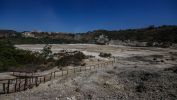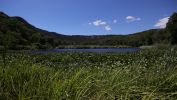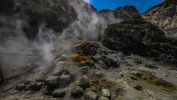It looks like you're using an Ad Blocker.
Please white-list or disable AboveTopSecret.com in your ad-blocking tool.
Thank you.
Some features of ATS will be disabled while you continue to use an ad-blocker.
share:
I agree. While Yellowstone may get a lot of attention due to it's location, but the real danger people should be watching is Kikai Caldera in Japan.
From: The WIKI
From: Post Courier February 13, 2018
So while Yellow Stone may get more attention, this growing giant is more likely to blow then the American Super Volcano. Scary stuff.
From: The WIKI
Kikai Caldera was the source of the Akahoya eruption, one of the largest eruptions during the Holocene (10,000 years ago to present). About 6,300 years ago or 4,300 BC, pyroclastic flows from that eruption reached the coast of southern Kyūshū up to 100 km (62 mi) away, and ash fell as far as Hokkaidō. The eruption produced about 150 km³ of tephra, giving it a Volcanic Explosivity Index of 7 and making it one of the most explosive in the last 10,000 years, ranking alongside Santorini, Changbaishan, Crater Lake, Kurile Lake and Tambora
From: Post Courier February 13, 2018
A research paper published in Nature Scientific Reports states a lava dome is expanding within the Kikai Caldera.
This is just 50km south of Kyushu — Japan’s most southerly main island.
The dome itself is 9.5km wide. The seabed has been forced upwards some 610 meters by more than 31 cubic kilometres of lava.
Its peak sits just 30m beneath the ocean waves.
But the dome is not in itself a problem.
It’s what it represents.
It means a vastly bigger crucible of magma below has begun building up pressure once again.
If it bursts, researchers say it could kill some 100 million people.
So while Yellow Stone may get more attention, this growing giant is more likely to blow then the American Super Volcano. Scary stuff.
originally posted by: Imagewerx
It wasn't all that long ago that Campi Flegrei/Volcano Solfatara near to Naples in Italy was going to be 'the next big one'.Then like all the other 'next big ones' not a lot happened.

Lets hope that one doesn't go off, it would make Pompeii look like a science experiment. Naples and surrounding area would be toast as well as the 1.5 million people that live in the area. PBS has recently been showing a documentary about the region, it's very interesting and well worth the watch.
a reply to: mtnshredder
As I would imagine they all share the same magma chamber,Astroni and Vesuvius would probably get quite angry as well.
As I would imagine they all share the same magma chamber,Astroni and Vesuvius would probably get quite angry as well.
originally posted by: Imagewerx
a reply to: mtnshredder
As I would imagine they all share the same magma chamber,Aston and Vesuvius would probably get quite angry as well.
Yes they do, the Campanian volcanic arc includes Vesuvius (Pompeii) and Phlegraean Fields (Naples) which includes Campi Flegrei and many others volcanoes. I believe there is 24 volcanoes in total. Camp Flegrei is the one they're really concerned with, it would be catastrophic to say the least.
a reply to: mtnshredder
I would also guess that Etna and Stromboli share the same magma chamber as both seem to be almost constantly active?
I did the walking tour around the bottom of the crater of Astroni and it's scale is just mind blowing.It's a shame I couldn't find anywhere to get a photo looking down into it from the top.

I would also guess that Etna and Stromboli share the same magma chamber as both seem to be almost constantly active?
I did the walking tour around the bottom of the crater of Astroni and it's scale is just mind blowing.It's a shame I couldn't find anywhere to get a photo looking down into it from the top.

a reply to: mtnshredder
I gather that Santorini is currently dormant. Could it be a candidate? Not well up on such things, just curious cos we like our hols to Greece.
I gather that Santorini is currently dormant. Could it be a candidate? Not well up on such things, just curious cos we like our hols to Greece.
a reply to: Imagewerx
In terms of supervolcano time, it may still be the next big one. Just because the press published a bunch of articles on it and nothing happened three days later means nothing in terms of geology. Fact is that the system is showing more signs of life than is comfortable meaning it could be building up to something, but since there aren't many actual supervolcanic eruptions that modern science has directly observed, we don't really know what the run-up would look like.
It could be a slow process of decades or more, or it could be really, really fast. No one actually knows because we've never seen it happen. At best, they can extrapolate based on what they know about other, more traditional volacanoes, and they really don't know all that much about them, either. More certainly, but not enough to get them right all the time, either.
In terms of supervolcano time, it may still be the next big one. Just because the press published a bunch of articles on it and nothing happened three days later means nothing in terms of geology. Fact is that the system is showing more signs of life than is comfortable meaning it could be building up to something, but since there aren't many actual supervolcanic eruptions that modern science has directly observed, we don't really know what the run-up would look like.
It could be a slow process of decades or more, or it could be really, really fast. No one actually knows because we've never seen it happen. At best, they can extrapolate based on what they know about other, more traditional volacanoes, and they really don't know all that much about them, either. More certainly, but not enough to get them right all the time, either.
Bárðarbunga could erupt soon. It's erupted recently on:
1996
2010
2014–2015
It shouldn't be too severe of an eruption and it's only a prediction that it might erupt within maybe the next 5 years.
Yellowstone is going to erupt eventually, maybe not in my lifetime or even this century but it will build up to something.
If Yellowstone started to spike in activity I would suggest letting nature do what it's supposed to do and get as far away from the harmful zones as possible. We need a super volcano to fix the changing climate anyway, NASA's idea won't work.
1996
2010
2014–2015
It shouldn't be too severe of an eruption and it's only a prediction that it might erupt within maybe the next 5 years.
Yellowstone is going to erupt eventually, maybe not in my lifetime or even this century but it will build up to something.
If Yellowstone started to spike in activity I would suggest letting nature do what it's supposed to do and get as far away from the harmful zones as possible. We need a super volcano to fix the changing climate anyway, NASA's idea won't work.
originally posted by: mtnshredder
a reply to: Imagewerx
I don't believe they do connect, Stromboli is in the Calabrian volcanic arc on the Eurasian plate. Vesuvius is in the Campanian volcanic arc on the African plate. At least thats the way I understand what I've read.
I was talking about Etna though,which is only about 50 miles or so from Stromboli?
Maybe this helps.


Mount Etna is associated with the subduction of the African plate under the Eurasian plate, which also produced Vesuvius and Campi Flegrei, but is part of a different volcanic arc (the Calabrian rather than Campanian). A number of theories have been proposed to explain Etna's location and eruptive history, including rifting processes, a hot spot, and intersection of structural breaks in the crust. Scientists are still debating which best fits their data, and are using a variety of methods to build a better image of the Earth's crust below the volcano.


edit on 7-3-2019 by mtnshredder because: (no reason given)
a reply to: RobertCavitt
you are very wrong, the next Caldrea forming eruption will most likely be in or very near long valley california and ill tell you why, because the last time that doozy erupted was 760,000.00 years ago. and I suspect it will be as big as the last eruption at Yellowstone.
you are very wrong, the next Caldrea forming eruption will most likely be in or very near long valley california and ill tell you why, because the last time that doozy erupted was 760,000.00 years ago. and I suspect it will be as big as the last eruption at Yellowstone.
new topics
-
How long till it starts
US Political Madness: 2 minutes ago -
USSS Agent Fired for Having Sex In Michelle Obama's Bathroom
US Political Madness: 1 hours ago -
Watching TV
Jokes, Puns, & Pranks: 4 hours ago
top topics
-
RFK is Trumps health pick
2024 Elections: 12 hours ago, 19 flags -
USSS Agent Fired for Having Sex In Michelle Obama's Bathroom
US Political Madness: 1 hours ago, 6 flags -
Watching TV
Jokes, Puns, & Pranks: 4 hours ago, 5 flags -
How long till it starts
US Political Madness: 2 minutes ago, 0 flags
active topics
-
How long till it starts
US Political Madness • 0 • : DAVID64 -
FLORIDA Sues Biden-Harris FEMA for Denying Disaster Assistance to Homeowners with TRUMP Signs.
US Political Madness • 47 • : network dude -
USSS Agent Fired for Having Sex In Michelle Obama's Bathroom
US Political Madness • 12 • : WeMustCare -
WATCH LIVE: US Congress hearing on UFOs, unidentified anomalous phenomena
Aliens and UFOs • 68 • : WeMustCare -
The Reactionary Conspiracy 13. The plot’s theology.
General Conspiracies • 296 • : MarxistDebunker2 -
Thune selected as Senate Republican Leader
US Political Madness • 72 • : CriticalStinker -
The art of being offended
Social Issues and Civil Unrest • 38 • : bastion -
Post A Funny (T&C Friendly) Pic Part IV: The LOL awakens!
General Chit Chat • 7774 • : underpass61 -
The Acronym Game .. Pt.4
General Chit Chat • 955 • : tinkerbell99 -
RFK is Trumps health pick
2024 Elections • 8 • : marg6043


